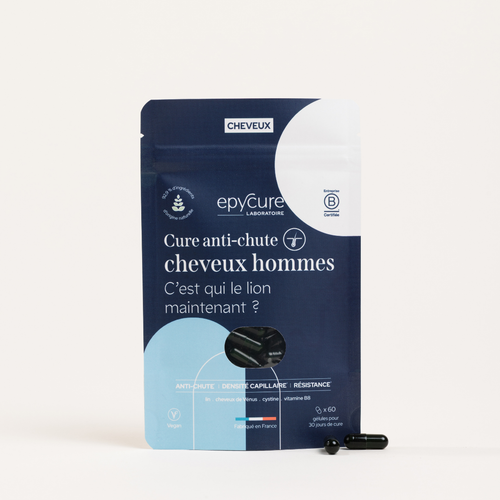Seasonal hair loss is very common and affects a large majority of the population, both men and women. If it is harmless for many, it is a factor of anxiety for others. But then where does this hair loss come from and how can we overcome it with a few easy-to-apply daily actions?
WHAT TO REMEMBER- Chronic, progressive and lasting hair loss is linked to a genetic predisposition and/or the action of androgenic hormones (e.g. testosterone).
- Reactive hair loss , often sudden, is often linked to intense stress, the environment or health, and naturally decreases over time. It generally appears 2 to 3 months after the stressful event.
- If hair loss exceeds 100 hairs lost per day or if one area of the scalp loses more hair than the rest of the skull, in this case we speak of abnormal and excessive hair loss .
- The hair life cycle is made up of three distinct phases: anagen, catagen, telogen . Throughout its life, hair grows, lives, regresses and then falls out.
- In autumn the fall process is known to be particularly significant. This fall is often caused by hormonal changes, back-to-school fatigue and excess sun - chlorine - salt in summer.
- A course of food supplements, a diet rich in nutrients, head massages, a peaceful daily life and restful sleep, we give you all our advice for taking care of your hair.
What is the difference between reactive and chronic hair loss?
Hair loss can be localized (top of the head) or diffuse (entire head), temporary (less than 6 months) or lasting (more than 6 months). Classic baldness in men is an example of chronic, localized and lasting hair loss, unlike reactive hair loss, generally diffuse and temporary, often found in women.
Reactive hair loss (diffuse and temporary loss)
When hair loss appears suddenly, it is often reactive hair loss. As its name suggests, this phenomenon occurs in reaction to an external event , in the vast majority of cases linked to intense stress . It generally appears 2 to 3 months after the event in question and is more common in women , generally affecting the entire skull .
We can list several triggering events , which obviously vary from one person to another depending on their sensitivity or their state of health, both physical and mental:
- Stress : intense emotional stress, even trauma,
- Physiological state : pronounced fatigue, pregnancy (iron deficiency for example), childbirth (sudden drop in estrogen hormones), breastfeeding,
- Health : an illness, certain drug treatments, a major surgical operation requiring general anesthesia,
- Environment : seasonal changes, such as the transition to fall or spring,
- Diet : a dietary deficiency, diet or sudden weight loss.
This type of hair loss, although impressive, is far from irreversible. Very often, only the hair dies, so the bulb is still able to produce new hair. It thus decreases naturally after a few weeks , or even a few months, and does not require any particular treatment, even if it can sometimes be interesting to opt for a course of food supplements to limit hair loss and boost regrowth.
Chronic hair loss (localized and lasting hair loss)
Androgenetic (or androgenic) alopecia is progressive and long-lasting hair loss .
Also called male pattern baldness , it results in the appearance of finer and less pigmented hair on the top of the head (localized loss). It may uniformly affect the top of the head or start by affecting the tip of the head or temples. Over time, the hair gradually gives way to down which in turn disappears. In men, this hair loss becomes more common with age . To limit androgenetic hair loss, you can opt for food supplements such as the Anti-Hair Loss Cure which acts effectively on androgenic hormones and thus prevents baldness.
More rarely, androgenetic alopecia can be observed in women. In this case, hair loss affects the entire skull (diffuse hair loss). Unlike men, hair loss is never complete in women, hair persists even if it is thinning. It can appear at any age , sometimes even at puberty, but is more common from menopause onwards .
This hair loss results from two main factors:
- A genetic predisposition : the genes predisposing to androgenetic alopecia have been identified, one is carried by the X chromosome, transmitted to men by their mother. The risk of baldness is therefore higher when it is already present in the maternal family.
- The action of androgens : depending on the genetic background of each man, the hair follicles on the top of the head may be more or less sensitive to the action of androgens, the male sex hormones, in particular a derivative of testosterone. This hormone will accelerate and shorten the hair growth cycle. The hair then becomes finer, less dark and falls out more quickly.
Furthermore, other factors can promote this hair loss in women, such as oral contraceptives, hormonal treatments for menopause or excess stress.
When should you start worrying about hair loss?
We must keep in mind that every day we all lose between 50 to 100 hairs . This should absolutely not be a source of concern because it is a normal loss which simply depends on the natural sequence of life cycles of the hair . Our hair is born, grows and dies.
On the other hand, if the hair loss exceeds 100 hairs lost per day or if an area of the scalp loses more hair than the rest of the skull, in this case we speak of excessive hair loss . It is therefore essential to understand what type of hair loss it is: chronic or reactive hair loss ?
As explained just above, if hair loss occurs suddenly and suddenly, especially after intense stress, it is reactive hair loss. No need to panic, the fall should slow down over the weeks. However, if hair loss occurs gradually and we lose density and volume, then it is chronic hair loss. In this case, it may be interesting to see a specialist to determine the exact cause(s) of the fall and act quickly.
What causes seasonal hair loss?
Understanding the hair cycle
Throughout its life, hair grows, lives, regresses and then falls out. The hair life cycle is made up of three distinct phases :
- The anagen phase : this is the hair growth phase which lasts between 2 and 5 years . The hair follicle produces hair which will grow at a rate of approximately 2 millimeters per week .
- The catagen phase : this is the rest phase , a fairly short transition period ( between 2 and 3 weeks ) during which hair growth gradually ends .
- The telogen phase : this is the last phase of the hair, the one which leads to its loss . The dead hair remains attached to the scalp for approximately 3 months before falling out. As soon as it falls, the follicle resumes a growth phase.
Why do we lose more hair in the fall?
It happens that when the seasons change, hair loss is two to three times more severe than usual: this is called seasonal hair loss or temporary alopecia (around four weeks). And in autumn the fall process is known to be particularly significant. It can reach up to 300 hairs lost per day . But then why do we lose so much hair in autumn?
- Hormonal change : Generally speaking, we experience a peak in hair growth in summer. Indeed, exposure to the sun increases the secretion of hormones that govern hair growth. When autumn arrives, the lack of light and the difference in temperature inevitably lead to a hormonal change which directly impacts hair growth.
- Impact of summer : After this summer period of growth and maturity, some of the hair reaches the end of its life and falls out. Indeed, in summer, hair is subjected to well-known attacks which promote its oxidation and drying (sun trio, chlorine and salt). These attacks have direct repercussions in autumn since an attacked hair takes around three months to fall out. This is called the fall cycle.
- Back-to-school fatigue : This drop can also be encouraged by stress and fatigue which generally occur during the fall period and coincide with the start of the school year and a more intense pace of life.
How to fight seasonal hair loss?
Without completely stopping the process of seasonal hair loss, certain simple everyday actions already help to strengthen it and limit its loss. We give you our 5 best tips:
1. Follow a course of food supplements
Dietary supplements can greatly improve hair growth and strength and can easily be incorporated into your hair routine. B group vitamins , in particular vitamin B8 also known as biotin, are well known for stimulating the production of keratin and thus allowing the cells of the hair follicle to renew themselves. There are also plant extracts that are particularly effective for hair health. For example, pea shoots provide everything hair needs for its growth. A scientific study also showed that they were capable of reducing the hair loss phase (halving of hair lost per day after 15 days of treatment). We therefore added this miracle ingredient within a complex of vitamins and minerals to develop our Hair & Nail Cure . A complete food supplement that guarantees the beauty and good health of hair, especially during seasonal changes! If it's gummies that tempt you, Hair & Nail Gummies can just as easily become your new ally to boost hair growth (small bonus for their natural orange aroma).
2. Adopt a balanced, nutrient-rich diet
A balanced diet plays an essential role here. Pay attention to the foods you put on your plate because the right intake of vitamins and minerals is essential in the hair cycle . They must reach the scalp in sufficient quantity to nourish it well and encourage hair growth . Iron ( dark chocolate, white or red beans, hazelnuts, etc.), vitamin B5 (egg yolks, whole grains, soy, lentils, etc.) and zinc (sprouted seeds, animal proteins, etc.) to stop the fall, vitamin B8 (legumes, nuts, banana, etc.) and vitamin B9 (legumes, green leafy vegetables, etc.) to boost growth, vitamin A (carrots, sweet potatoes, etc.) to bring shine to hair, and many more.
3. Regularly massage your scalp with essential or vegetable oils
In addition to being relaxing, head massages promote blood flow, oxygenation of the scalp and hair growth . Exercise circular movements on your head, with your fingertips, for a few minutes, applying moderate pressure and focusing on the areas affected by the fall. Hair that is better oxygenated, breathes and lives better. You can optimize the effectiveness of your head massage using oils . Certain essential oils have surprising properties on the hair fiber. Atlas cedar essential oil fights against oily hair while helping to maintain volume, grapefruit or clary sage essential oils help to fight hair loss and Bay Saint Thomas essential oil helps to stimulate hair growth. . Vegetable oils can also be interesting. Avocado vegetable oil helps to nourish the hair, black seed oil helps to soothe irritated scalps and castor and mustard oils respectively help to strengthen the hair bulb and stimulate microcirculation to boost hair growth. hair.
4. Protect your hair from external aggressions
Our hair is particularly sensitive to environmental changes , especially those we experience during seasonal changes. In winter, consider a hat to protect your hair from the cold and in summer, avoid oxidation due to the sun, chlorine and salt by opting for a hat and systematic rinsing after a dip in the pool or in the sea. To find out more, I invite you to consult our article on how to take care of your hair in summer .
Beyond seasonal changes, water temperature is also a factor that directly impacts hair health. Washing your hair with water that is too hot can seriously damage the hair fiber, so opt for lukewarm or even cold water . The latter has the advantage of promoting hair growth and tightening the pores of the scalp.
Finally, use the minimum temperature of the hair dryer and hold it away from your scalp to avoid harming the hair cuticles. Obviously not drying your hair at maximum power does not mean abandoning drying and going out with wet hair because they are not fans of extreme temperature variations.
5. Relax and sleep well for healthy hair
There is a significant link between lack of sleep and hair loss. The less you sleep, the more you tend to stress. Indeed, dealing with insomnia, nighttime awakenings, etc., leads to emotional hyperactivity . Thus, you let yourself be overcome more easily by stress and irritability. However, as we saw above, stress is the number one factor responsible for hair loss. So, it is essential to find restful sleep and a peaceful daily life. For this, you can opt for physical exercise to improve your physical and mental health (not just before going to sleep obviously) or train yourself in relaxation and meditation techniques (sophrology, yoga, cardiac coherence) to channel your thoughts towards the positive. For more tips for great sleep, we invite you to read our article on how to improve the quality of sleep effectively.






